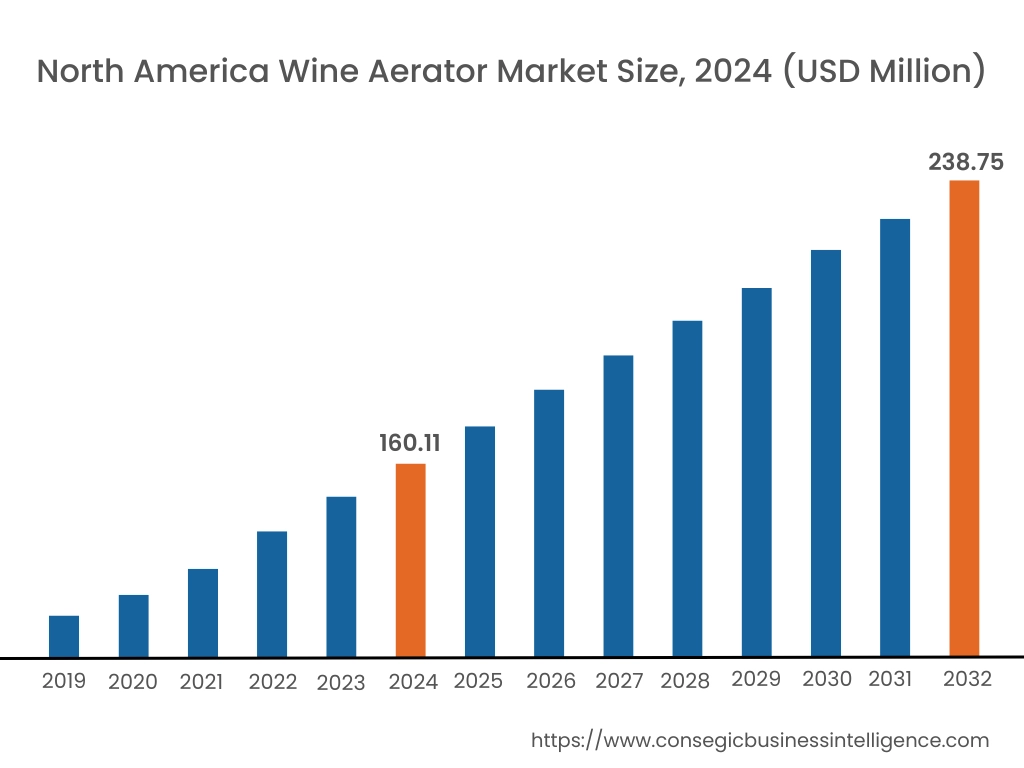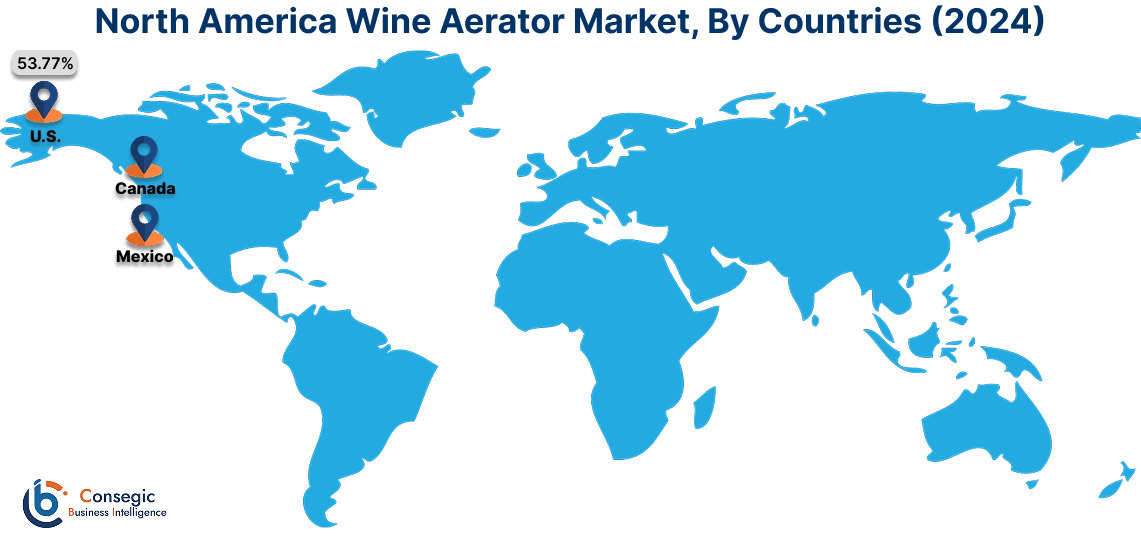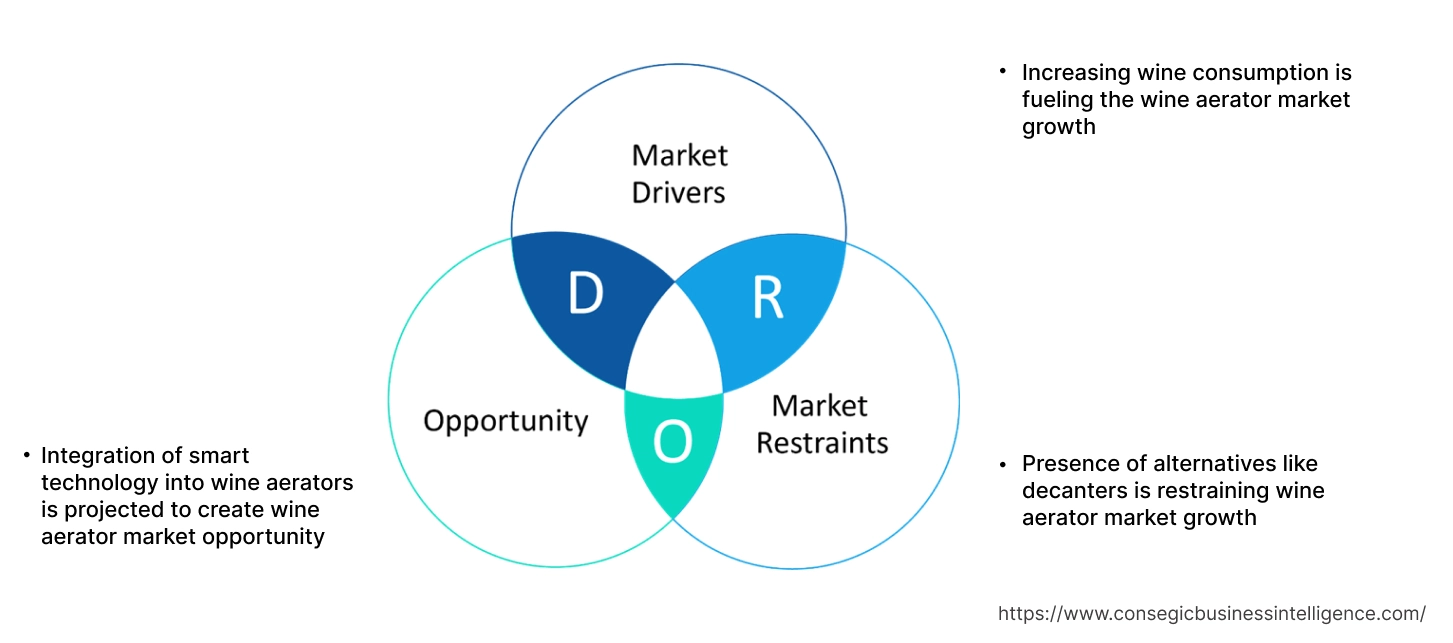- Summary
- Table Of Content
- Methodology
Wine Aerator Market Size:
Wine Aerator Market Size is estimated to reach over USD 654.12 Million by 2032 from a value of USD 439.86 Million in 2024 and is projected to grow by USD 454.58 Million in 2025, growing at a CAGR of 5.5% from 2025 to 2032.
Wine Aerator Market Scope & Overview:
A wine aerator is a device designed to enhance the flavor and aroma of wine by exposing it to oxygen as it's poured. This process, known as aeration, helps to soften the wine's tannins, release its full aromatic potential, and allow its various flavor notes to become more noticeable. By increasing the surface area of the wine as it interacts with air, through specially designed chambers, an aerator speeds up the "breathing" process that occurs when wine is swirled in a glass, providing a more intense aeration.
Key Drivers:
Increasing wine consumption is fueling the wine aerator market growth
The wine aerator market is expected to grow due to the increasing number of wine consumers. Even with stable per capita wine consumption, a larger population of wine drinkers inherently expands the potential customer base for products like wine aerators. Furthermore, frequent wine drinkers are more likely to experiment with different wines and seek ways to enhance their tasting experience, making wine aerators a valuable tool. The rising popularity of wine as a beverage also boosts its appeal as a gift, and wine accessories, including aerators, are often chosen as thoughtful and practical presents for wine lovers, further driving the wine aerator market size.
- For instance, in 2023, the total wine consumed in the United States reached 899 million gallons, with table wine accounting for a significant portion at 759 million gallons. This translated to approximately 2.68 gallons consumed per resident.
Consequently, increasing wine consumption is driving the wine aerator market expansion.
Key Restraints:
Presence of alternatives like decanters is restraining wine aerator market growth
Both aerators and decanters aim to enhance the wine's aroma and flavor by exposing it to oxygen. While aerators provide rapid, immediate aeration as the wine is poured, decanters offer a more gradual aeration over a longer period. Additionally, decanters offer the significant advantage of separating wine from sediment, a crucial function for older or unfiltered wines. Aerators, in general, do not effectively address this issue and can even become clogged by sediment. Consumers who frequently drink wines with sediment may prioritize decanters for this dual functionality.
Therefore, as per the analysis, these combined factors are significantly hindering wine aerator market share.
Future Opportunities :
Integration of smart technology into wine aerators is projected to create wine aerator market opportunity
Smart aerators analyze the type of wine, vintage, and even user preferences through connected apps. Additionally, these aerators feature automated dispensing and aeration processes with a simple touch of a button or via a mobile app. This ease of use appeals to consumers and some devices even offer one-touch control for both aerating and pouring. Moreover, connected apps associated with smart aerators provide users with information about the wine they are drinking, including optimal serving temperature, food pairing suggestions, and detailed tasting notes, thus significantly boosting wine aerator market demand.
- For instance, Vinaera Pro electric wine aerator features an adjustable aeration function, allowing users to control the level of oxygen exposure with a turn of a dial, effectively mimicking different decanting times. While not directly integrated with a smartphone app for wine recognition, the adjustable setting provides a degree of personalized aeration based on the user's knowledge or preference for the specific wine. It also includes a built-in sediment filter and one-touch dispensing.
Hence, based on the analysis, integration of smart technology into wine aerators is expected to create wine aerator market opportunities.
Wine Aerator Market Segmental Analysis :
By Product Type:
Based on the product type, the market is categorized into manual wine aerators and electric wine aerators.
Trends in the Product Type:
- Electric wine aerators are gaining traction due to their convenience and rapid aeration capabilities.
- Growing trend towards the innovation in manual aerator design which focus on maximizing the oxygen exposure during the pour.
Manual Wine Aerators accounted for the largest revenue share in 2024.
- Development of multi-stage aeration systems, incorporating features like internal vanes, diffusers, and vortex chambers to create a greater surface area for wine to interact with air is driving wine aerator market share.
- Growing trend towards using higher-quality materials such as food-grade stainless steel and durable, BPA-free plastics in manual aerator construction is boosting industry expansion.
- Manufacturers are innovating the ergonomics of manual aerators including designing comfortable grips, non-drip spouts to prevent mess during pouring, and easy-to-clean components, hence spurring the wine aerator market size.
- For instance, Vintorio Wine Aerator Pourer is highly rated manual wine aerator designed for ease of use and instant wine enhancement. It utilizes the Bernoulli Effect with a large aerating chamber and air intake system to infuse wine with the optimal amount of oxygen as you pour. This process helps to open up the wine, releasing its full aromas and flavors in under 30 seconds.
- Thus, as per the wine aerator market analysis, the aforementioned factors are driving the manual wine aerator segment.
Electric Wine Aerators are predicted to register the fastest growth during the forecast period.
- Increasing technological advancements in electric wine aerators characterized by innovation, including adjustable airflow and timing controls for more precise aeration.
- Incorporation of smart features like Bluetooth connectivity and smartphone apps for remote control and personalized aeration recommendations is driving the market size.
- Advanced electric models are becoming more compact and portable, enhancing their usability.
- For instance, Wine Enthusiast handheld, battery-operated aerator is designed for portability and convenience. It typically features a simple one-touch operation and claims to aerate wine significantly faster than traditional pouring.
- In conclusion, the above-mentioned factors are contributing significantly in spurring the market trend.
By Material:
Based on the material, the market is classified into plastic, stainless steel, glass, and others.
Trends in the Material:
- Manufacturers continue to innovate with plastic designs, focusing on effective aeration through features like optimized chambers and air intake systems.
- Growing trend towards the adoption of glass aerators for their sophisticated appearance, offering a touch of elegance to the wine-drinking ritual.
Stainless Steel accounted for the largest revenue share of 49.84% in 2024 and is also predicted to register the fastest growth.
- Stainless steel is favored for its robustness and long lifespan, appealing to consumers looking for a more durable product, thereby driving wine aerator market trend.
- Moreover, the sleek and modern appearance of stainless-steel aerators position them as a more premium option, aligning well with contemporary kitchen and barware, further driving the wine aerator market demand.
- Additionally, stainless steel does not impart any unwanted flavors or odors to the wine, which is a key consideration for wine enthusiasts.
- Increasing demand for stainless steel used in electric wine aerators for both functional components and external casing, contributing to a more premium feel.
- For instance, Le Creuset offers the Stainless Steel WA-163 Wine Aerator, featuring a patented 3-in-1 design with a dual-chamber system that effectively aerates wine for enhanced flavor.
- Thus, as per the wine aerator market analysis, the aforementioned factors are driving the stainless-steel segment.

By Application:
Based on the application, the market is classified into home use and commercial use.
Trends in the Application:
- Hospitality industry including restaurants, bars, wine bars, and hotels are increasingly using wine aerators to enhance their wine service and improve customer satisfaction.
- Commercial users demand robust and efficient aerators that can withstand frequent use and quickly enhance the quality of the wines they serve.
Home Use accounted for the largest revenue share in 2024 and is also predicted to register the fastest growth.
- The increasing trend of consumers hosting gatherings and wine tasting events at home is a significant driver for the adoption of wine aerators.
- Home users often prefer simple and easy-to-use aerators, contributing to the popularity of manual and basic electric models.
- Additionally, as home bars and wine corners become more common, the visual appeal of wine accessories, including aerators, is gaining importance.
- E-commerce platforms provide easy access for home users to a wide variety of wine aerators, contributing to market growth in this segment.
- Thus, as per the wine aerator market analysis, the aforementioned factors are driving the home use segment trend.
Regional Analysis:
The global wine aerator market has been classified by region into North America, Europe, Asia-Pacific, Middle East & Africa, and Latin America.

North America region was valued at USD 160.11 Million in 2024. Moreover, it is projected to grow by USD 165.50 Million in 2025 and reach over USD 238.75 Million by 2032. Out of these, U.S. accounted for the largest revenue share of 53.77% in 2024. North American market is witnessing a continuous influx of innovative wine aerator designs, including both manual and electric models. There's a growing interest in electric aerators with smart features and adjustable settings, catering to consumers seeking a more controlled aeration process. Additionally, the well-established e-commerce landscape in North America provides easy access for consumers to purchase a wide variety of wine aerators from different brands and price points. Online platforms have become a significant distribution channel, contributing to market reach in United States.
- For instance, S. Census Bureau reported that estimated retail e-commerce sales in the fourth quarter of 2023 reached USD 285.2 billion, after adjusting for seasonal patterns but not price changes. This figure represents a 0.8 percent increase compared to the previous quarter (third quarter of 2023).

Europe was valued at USD 134.49 Million in 2024. Moreover, it is projected to grow by USD 139.34 Million in 2025 and reach over USD 206.05 Million by 2032.
Europe is home to some of the world's oldest and most prestigious wine regions. This long-standing tradition fosters a sophisticated understanding of wine and a keen interest among consumers in optimizing its enjoyment. Consequently, tools like wine aerators, which can demonstrably improve the taste and aroma, resonate with a significant portion of the population. Wine education programs are also becoming more prevalent, further promoting a deeper comprehension of wine and viticulture, which can lead to increased adoption of wine accessories.
As per the wine aerator market analysis, Asia Pacific wine aerator market is experiencing growth driven by increasing wine consumption in emerging economies, and a growing interest in western lifestyles. Additionally, Latin American wine aerator market is showing steady growth, influenced by expanding wine consumption in key countries and a developing appreciation for wine accessories. Moreover, Middle East and Africa wine aerator market is an emerging market, although from a smaller base, as wine culture gradually expands in certain regions.
Top Key Players and Market Share Insights:
The market is highly competitive with major players providing wine aerator to the national and international markets. Key players are adopting several strategies in research and development (R&D), product innovation, and end-user launches to hold a strong position in the market. Key players in the wine aerator industry include-
- Vinturi (USA)
- Aervana (USA)
- Soireehome (USA)
- Ullo (USA)
- Coravin (USA)
- Aveine (France)
- Zazzol (USA)
- VINVOLI (USA)
- TenTen Labs (USA)
- JIFAR (China)
- Trudeau (Canada)
- Rabbit (Metrokane) (USA)
Wine Aerator Market Report Insights:
| Report Attributes | Report Details |
| Study Timeline | 2019-2032 |
| Market Size in 2032 | USD 654.12 Million |
| CAGR (2025-2032) | 5.5% |
| By Product Type |
|
| By Material |
|
| By Application |
|
| By Region |
|
| Key Players |
|
| North America | U.S. Canada Mexico |
| Europe | U.K. Germany France Spain Italy Russia Benelux Rest of Europe |
| APAC | China South Korea Japan India Australia ASEAN Rest of Asia-Pacific |
| Middle East and Africa | GCC Turkey South Africa Rest of MEA |
| LATAM | Brazil Argentina Chile Rest of LATAM |
| Report Coverage |
|
Key Questions Answered in the Report
How big is the wine aerator market? +
The wine aerator market size is estimated to reach over USD 654.12 Million by 2032 from a value of USD 439.86 Million in 2024 and is projected to grow by USD 454.58 Million in 2025, growing at a CAGR of 5.5% from 2025 to 2032.
What specific segmentation details are covered in the wine aerator report? +
The wine aerator report includes specific segmentation details for product type, material, application, and regions.
Which is the fastest segment anticipated to impact the market growth? +
In the wine aerator market, electric wine aerator is the fastest-growing segment during the forecast period.
Who are the major players in the wine aerator market? +
The key participants in the Wine Aerator market are Vinturi (USA), Aervana (USA), Soireehome (USA), Üllo (USA), Zazzol (USA), VINVOLI (USA), TenTen Labs (USA), JIFAR (China), Rabbit (Metrokane) (USA) , Coravin (USA), Aveine (France), Trudeau (Canada), and Others.


